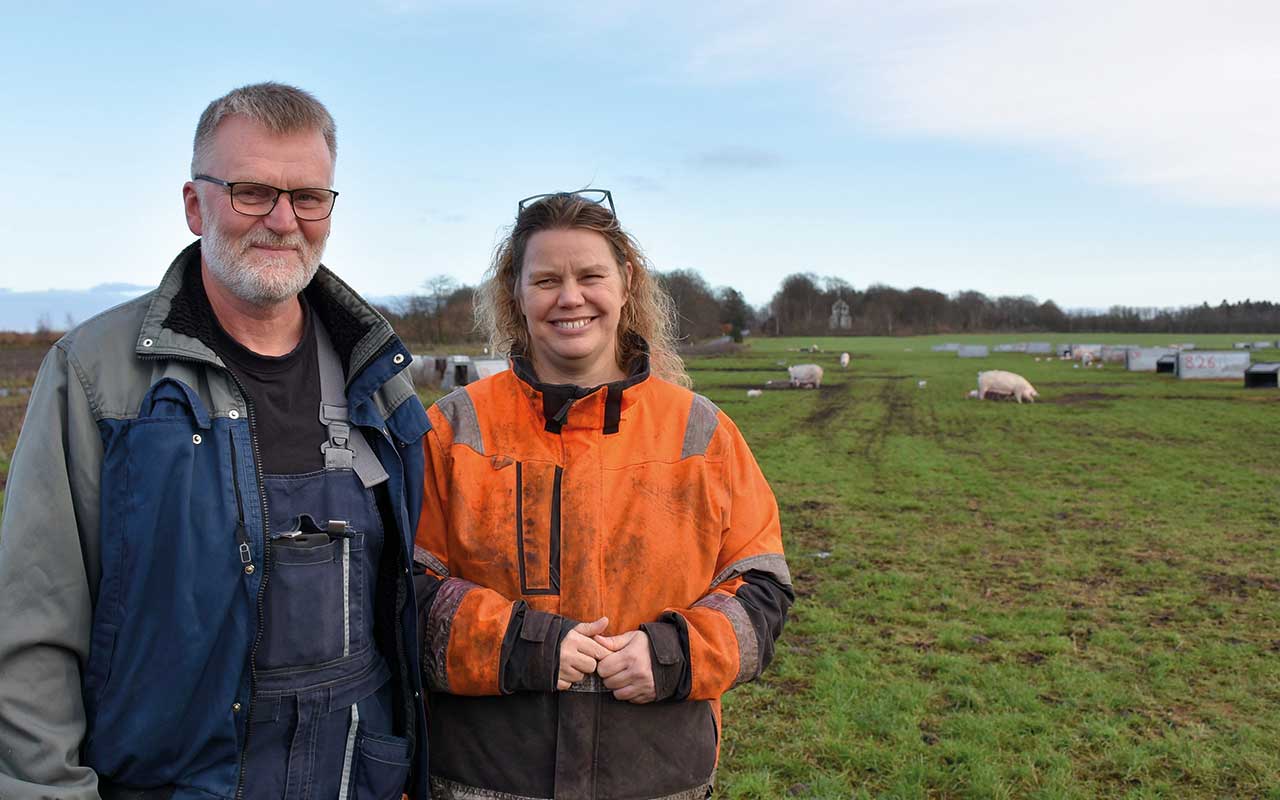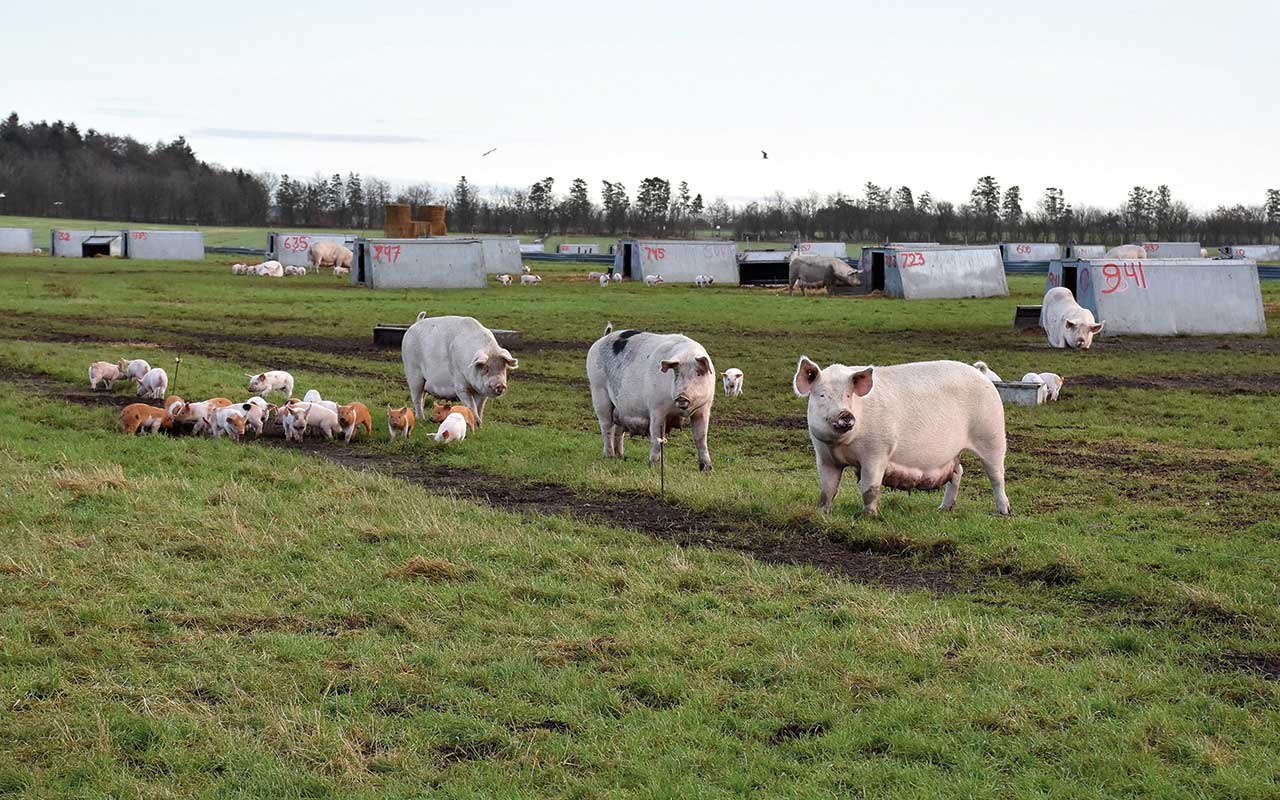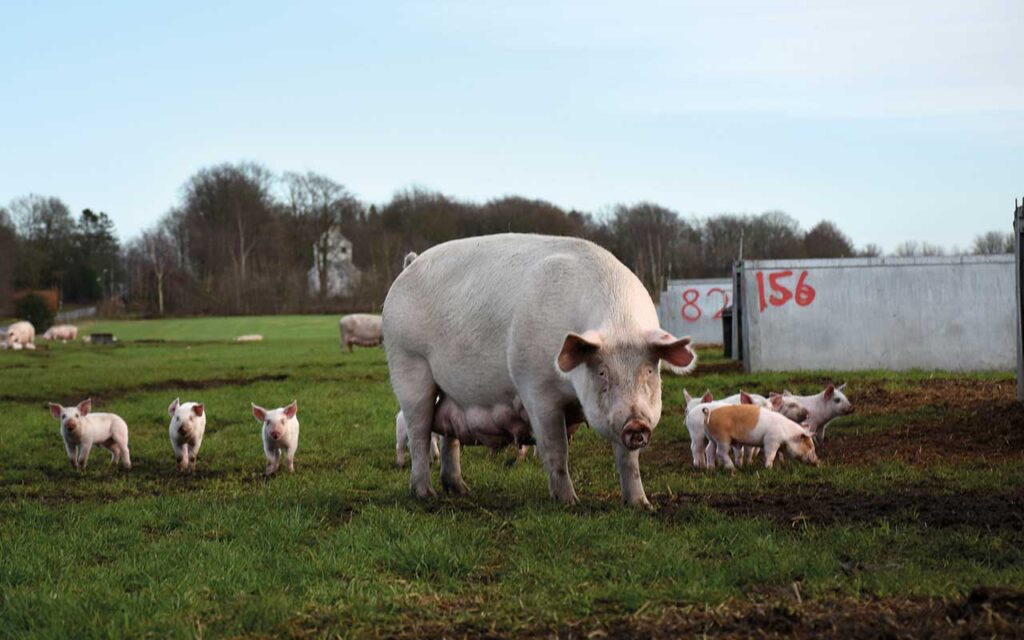It takes an entire day to feed all the pigs reared in the great outdoors on a farm in Denmark, such is the scale of the somewhat unique enterprise.
Denmark’s famous pig sector has never been readily associated with outdoor pig production. But Peter Bruun, 59, and his wife, Lene Conradsen, 48, run 1,100 sows outdoors on their Greensgaard Farm, located at Vorslunde, close to the small town of Give.
These sows produce around 30,000 pigs a year that are fattened for slaughter and sold under a rolling contract to the Rema 1000 supermarket chain.
The farm extends to 400ha, 100 of which are used to keep the pigs outdoors, and the rest is allocated for growing cereals as feed for the animals.

Farrowing takes place outdoors and the pigs are later moved indoors to complete the fattening process. Animal welfare is a priority on this farm, including in the fattening barn, where the pigs have ample space and access to an outdoor arena, the couple explained.
Each year the farm uses about 3,500 bales of wheat straw to bed the pigs, both outdoors and indoors, which are contract baled on 1,000ha.
At the end of the year, the outdoor pigs are moved onto fresh land, and the previous plot is regenerated by ploughing it up, before being planted with cereals and then returning to grass the next year.
This is quite a mammoth task, as there are some 30 miles of fencing to shift – it usually takes two months or more to move to the new location.
The farm employs 18-20 staff who come from eight countries. Each works a 37-hour week, receive regular training and they even attend yoga classes held on the farm to boost employee motivation and morale.
In terms of machinery, there are five tractors, each accumulating 1,000 hours a year, and four John Deere Gator machines, alongside feeding kit and other implements, making up the rest of the fleet.

Disease challenges
Denmark has, so far, escaped the threat posed by African swine fever in other key pig-producing countries, including neighbouring Germany. But there are other disease challenges pig farmers can face, as Peter and Lene found out.
Disaster struck in 2022 when the entire herd was hit by a viral disease and the couple decided to start over, this time with new pig genetics. This meant a switch from DanBred to Topigs Norsvin TN70 sows, crossed with Duroc DanBred boars.
“We prefer the TN70 breed as the litters are smaller – around 16 in number – but the piglets are bigger. They reach the slaughter weight of 94kg quicker, too,” Lene said.
The numbers are impressive for outdoor pig production. “Each sow averages 30 pigs a year with the outdoor system, compared to around 40 if indoors,” she added.
Feeding takes place every day from 7am to 3pm. The sows receive about 4.5kg each daily, depending on outside temperatures and whether they are nursing.
Piglets are weaned at 35 days old at an average weight of 11-12kg. During the five-week indoor fattening period, the pigs are fed according to size and age. This results in 1.75 feed units/kg growth from 11kg to 35kg, and then 2.75 feed units/kg growth from 35kg to 120kg.
The sows produce five litters of pigs before being slaughtered. The farm’s mortality rates are 4% for the sows and 4-5% from weaning to slaughter age.

Supply chain partnership
Twice a week, a truck visits the farm and collects 420 of the fattened pigs to transport them to a private slaughterhouse in Videbaek on Zealand, just a few hours away.
Staff at the slaughterhouse dedicate the entire day to killing Peter and Lene’s pigs, which are then transported to a number of processing hubs to be packaged for retail.
Given that their farm is quite unique in terms of outdoor pig farms of a similar size in Denmark, finding a specialist outlet for their meat was quite a challenge. But in 2018, they agreed terms with Rema 1000.
Peter said: “We are very happy with this agreement. We really feel there is a partnership with Rema 1000 regarding our product, and we have had a lot of direct contact with the consumers.”
“We wanted to sell our meat boosted with the story of the farm and how it was produced. This proved quite a challenge, as buyers didn’t seem so interested in this marketing concept.”
Finally, after trying a few buyers, Peter contacted Karsten Dejbjerg, the former CEO of the Friland retail group, who had started his own trading company. They now have a working arrangement where Lene and Peter produce the pigs, Karsten’s company, Tamaco, handles the logistics from farm to supermarket, and the supermarket sells the packaged meat.
Peter added: “We produce the pigs, then Tamaco is responsible for distributing the products from the pigs to the stores, which consist of independent shopkeepers who order two or three times a week.
“In the end there were some tough negotiations with Rema 1000, which was definitely not something we could do alone.
“Rema has been a fantastic partner and is really positive about our system of production. It is not an opponent, but a teammate, and we now feel the concept is something we share with it,” he said.
Peter and Lene’s responsibility to the brand goes beyond their photo on the packaging, as they also frequently interact directly with consumers.
For example, the couple host visitors to their ‘open farm’ event on the first Saturday of each month to see the pigs in the barn and the fields.
They also attend some of Rema’s stores to meet consumers, and interact with many more on social media to explain how the pigs are reared on the farm.
It is certainly a very different Danish pig unit and they are keen to highlight its attributes to the wider public.
The Danish pig industry
- Denmark is renowned as a leading pig producer in Europe, with pigmeat export accounting for about US$3bn in 2024.
- There are about 11.4m pigs in total in Denmark, which is almost twice the human population of the Scandinavian country. Just over 943,000 of these are sows.
- In terms of production, around 5,000 farms in Denmark produce approximately 28m pigs annually. Most pigs are slaughtered at the co-operative abattoirs, Danish Crown and Tican, but large numbers of live piglets are exported, mainly to Germany.
- Exports of pigmeat account for almost half of all agricultural exports and for more than 5% of Denmark’s total exports. More than 70% of Denmark’s pigmeat production is exported to other EU countries, with the rest distributed internationally.
- The meat is exported to over 140 countries, with the largest markets by volume being Germany, the UK, Poland, China, Japan, Italy, Russia and Sweden.
- It is quite unique to see pigs bred and raised outdoors in Denmark, with about 95% of commercial pigs produced indoors.
- Strict environmental regulations as well as climate factors make it tough for farmers wishing to run an outdoor pig production system.




